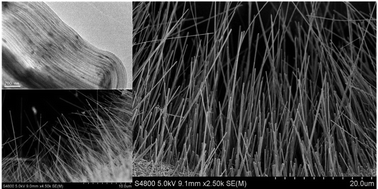Large-scale synthesis of Cu nanowires with gradient scales by using “hard” strategies and size effects on electrical properties†
Abstract
This paper describes an efficient synthesis system containing several “hard” approaches to fabricate copper nanowires (Cu NWs) with different scales (with outer diameters from 7 nm to 200 nm and lengths over several tens of micrometers). Both X-ray diffraction (XRD) and energy dispersive X-ray spectrometry (EDX) indicated that all products were pure copper without contamination. High resolution transmission electronic microscopy (HRTEM) images and selected area electron diffraction (SAED) patterns revealed the nanowires to be single crystals. They are potentially promising low-dimensional nanoscopic building blocks in optoelectronic applications. The electrical properties of the as-synthesized Cu NWs, with different diameters but equal lengths based on this system, have also been investigated. It was observed that the size of NWs influence their resistivities. In addition, residual value and the temperature dependence of the resistivities were experimentally found as the diameter decreases for the Cu NWs, which was in good agreement with the theoretical models. This investigation showed that only considering the temperature-dependent part arises from the electron–phonon interaction is not enough to get a complete understanding of the resistivity in nanowires. It was also necessary to further consider the temperature-independent part arises mainly from the surface scattering based on the size effects during demonstrative analysis.


 Please wait while we load your content...
Please wait while we load your content...